外研版(2019)选择性必修 第一册Unit 6 Nurturing nature Understanding ideas 课件(共24张PPT)
文档属性
| 名称 | 外研版(2019)选择性必修 第一册Unit 6 Nurturing nature Understanding ideas 课件(共24张PPT) | 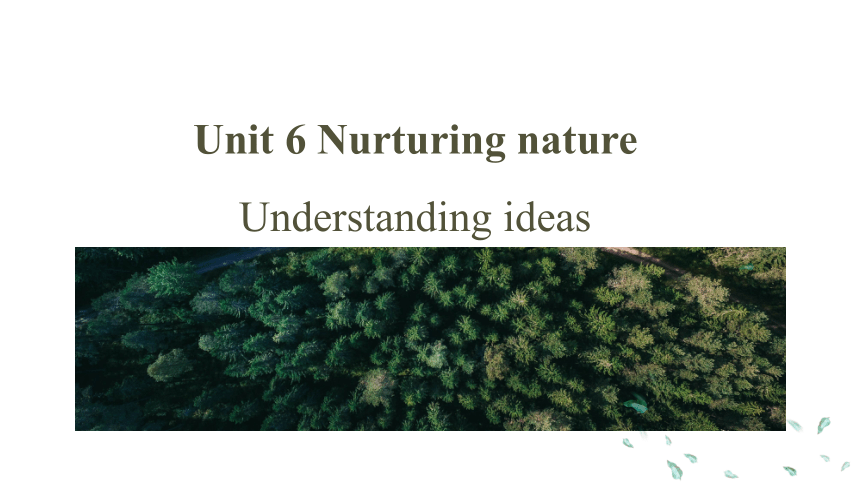 | |
| 格式 | pptx | ||
| 文件大小 | 9.0MB | ||
| 资源类型 | 教案 | ||
| 版本资源 | 外研版(2019) | ||
| 科目 | 英语 | ||
| 更新时间 | 2023-11-30 19:28:15 | ||
图片预览

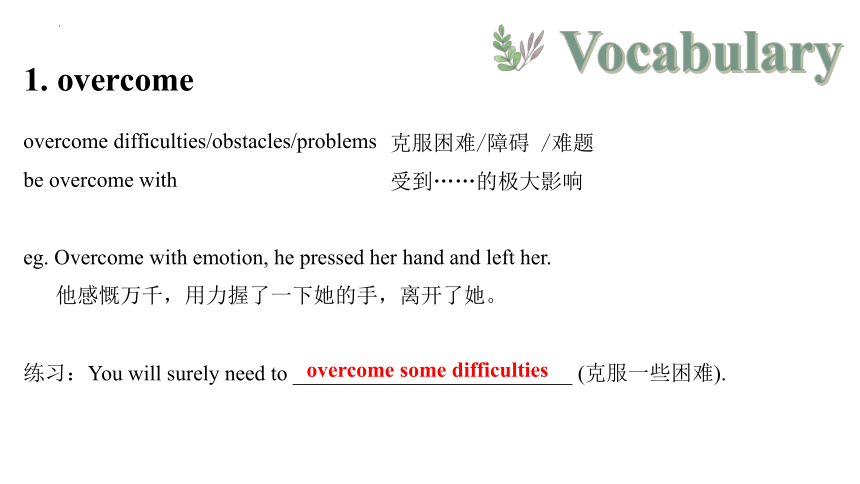
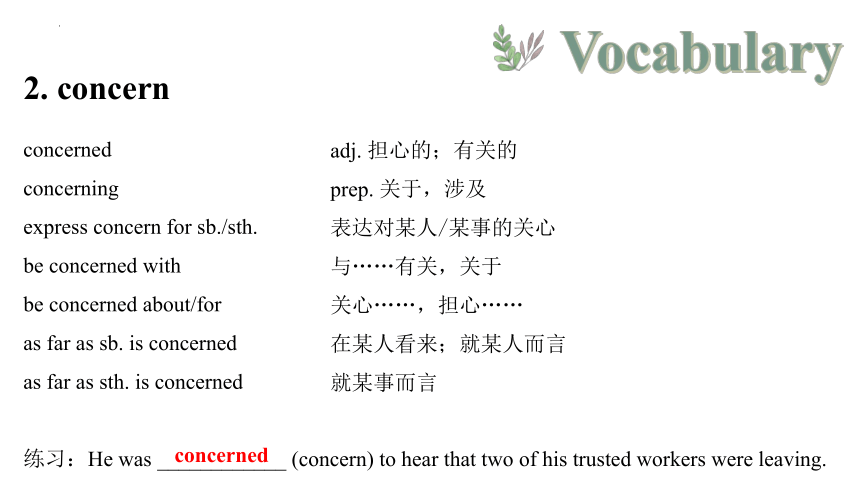
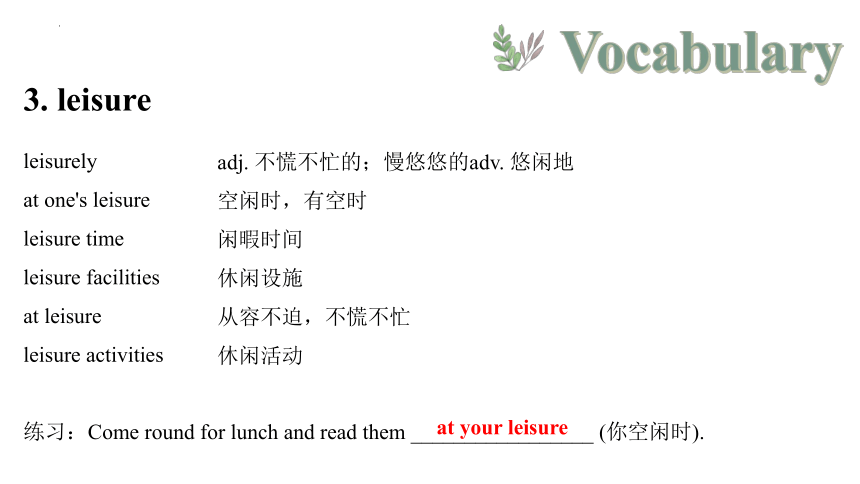
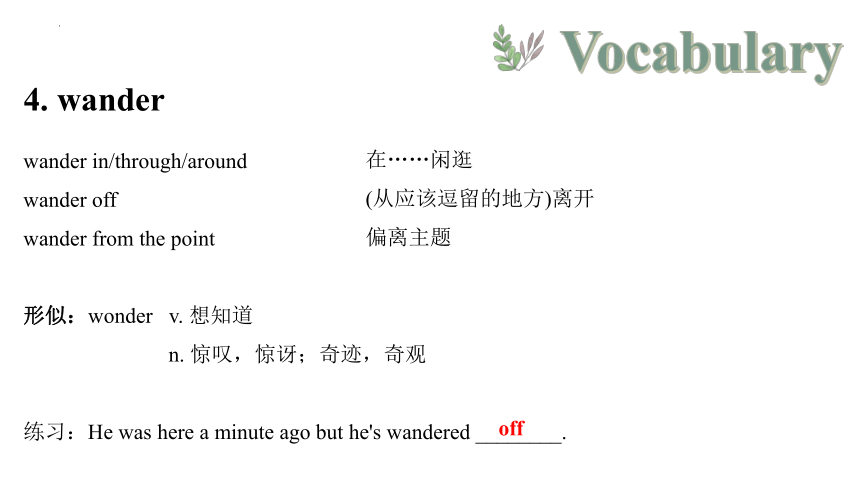
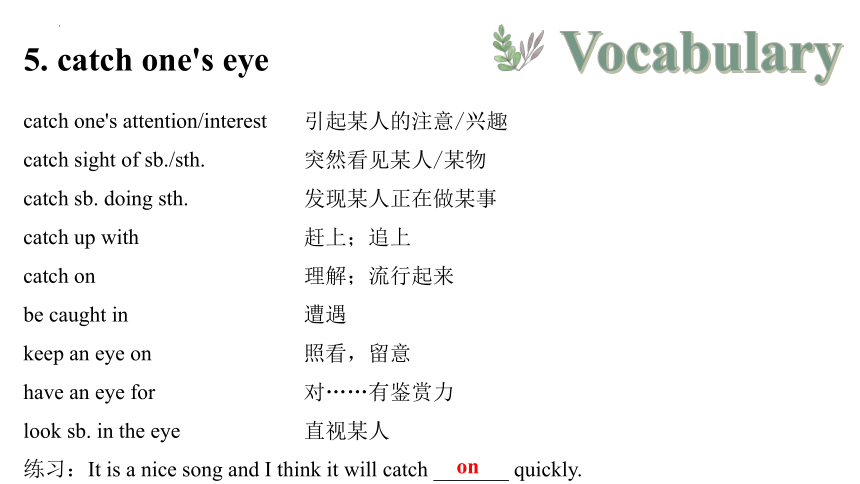
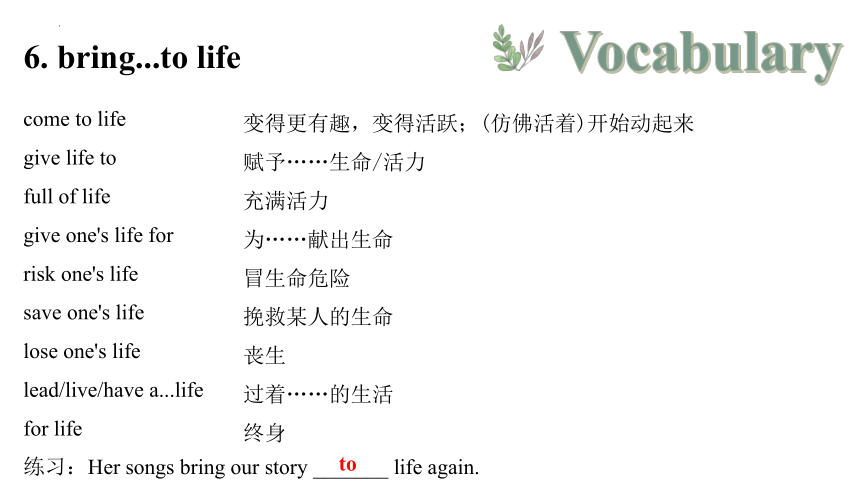

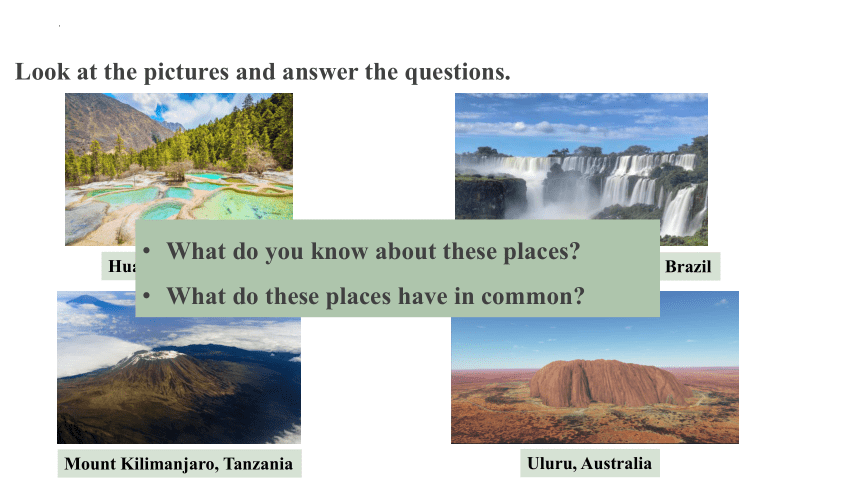
文档简介
(共24张PPT)
Unit 6 Nurturing nature
Understanding ideas
1. overcome
overcome difficulties/obstacles/problems
be overcome with
eg. Overcome with emotion, he pressed her hand and left her.
他感慨万千,用力握了一下她的手,离开了她。
练习:You will surely need to __________________________ (克服一些困难).
Vocabulary
overcome some difficulties
克服困难/障碍 /难题
受到……的极大影响
2. concern
concerned
concerning
express concern for sb./sth.
be concerned with
be concerned about/for
as far as sb. is concerned
as far as sth. is concerned
练习:He was ____________ (concern) to hear that two of his trusted workers were leaving.
Vocabulary
concerned
adj. 担心的;有关的
prep. 关于,涉及
表达对某人/某事的关心
与……有关,关于
关心……,担心……
在某人看来;就某人而言
就某事而言
3. leisure
leisurely
at one's leisure
leisure time
leisure facilities
at leisure
leisure activities
练习:Come round for lunch and read them _________________ (你空闲时).
Vocabulary
at your leisure
adj. 不慌不忙的;慢悠悠的adv. 悠闲地
空闲时,有空时
闲暇时间
休闲设施
从容不迫,不慌不忙
休闲活动
4. wander
wander in/through/around
wander off
wander from the point
形似:wonder v. 想知道
n. 惊叹,惊讶;奇迹,奇观
练习:He was here a minute ago but he's wandered ________.
Vocabulary
off
在……闲逛
(从应该逗留的地方)离开
偏离主题
5. catch one's eye
catch one's attention/interest
catch sight of sb./sth.
catch sb. doing sth.
catch up with
catch on
be caught in
keep an eye on
have an eye for
look sb. in the eye
练习:It is a nice song and I think it will catch _______ quickly.
Vocabulary
引起某人的注意/兴趣
突然看见某人/某物
发现某人正在做某事
赶上;追上
理解;流行起来
遭遇
照看,留意
对……有鉴赏力
直视某人
on
6. bring...to life
come to life
give life to
full of life
give one's life for
risk one's life
save one's life
lose one's life
lead/live/have a...life
for life
练习:Her songs bring our story _______ life again.
Vocabulary
变得更有趣,变得活跃;(仿佛活着)开始动起来
赋予……生命/活力
充满活力
为……献出生命
冒生命危险
挽救某人的生命
丧生
过着……的生活
终身
to
1
PART ONE
Leading-in
Do Activity 1~2 on Page 81.
Look at the pictures and answer the questions.
Huanglong, China
lguazú Falls, Argentina and Brazil
Mount Kilimanjaro, Tanzania
Uluru, Australia
What do you know about these places
What do these places have in common
Watch the video and answer the questions
What are the three types of World Heritage Sites
What other natural heritage sites in China do you know of
Suggested answers:
Cultural World Heritage sites, Natural World Heritage sites and Mixed World Heritage sites.
2
PART two
Pre-reading
Do Activity 1.
Work in pairs and complete the quiz. Try to guess if you are not sure of the answers.
Quiz
b
c
Do Activity 1.
Work in pairs and complete the quiz. Try to guess if you are not sure of the answers.
Quiz
c
b
3
PART three
While-reading
Read the passage quickly and find out why the railway is particularly special to the author.
Suggested answers:
The author has worked on the Qinghai-Tibet Railway. Once believed "impossible", the highest railway in the world is a record of the efforts of the workers to overcome the most difficult engineering challenges. These efforts and their end results mean that the railway is special to the author.
Read the passage again and choose the main ideas for the parts.
Part 1 (Para.1) __________________________
Part 2 (Paras.2~6) __________________________
Part 3 (Para.7) __________________________
A. How the workers protect the delicate ecosystem.
B. I'm proud that we built our "impossible" railway with the care that the environment deserves.
C. I'm about to travel along the railway that many foreign experts claimed was "impossible".
C
A
B
Read the passage and choose the best answers.
① According to many foreign experts, ____________________.
A. it would take a few years to build the railway
B. it would need a lot of machines to build the railway
C. only foreign companies could complete the task
D. it was impossible to build the railway
D
Read the passage and choose the best answers.
② What can we infer from the second paragraph
It took the workers less than a year to complete the railway.
The author was among the construction workers of the Qinghai-Tibet Railway.
The construction workers paid no attention to ecosystem protection while building the railway.
The construction workers didn't encounter the challenges foreign experts had expected.
B
Read the passage and choose the best answers.
③ Why were 675 bridges with a total length of about 160 kilometres built between Golmud and Lhasa
To protect wild animals.
To make sure the workers stayed healthy.
To protect Cuona Lake from construction waste.
To prevent damage to wetlands and grasslands.
D
Read the passage and choose the best answers.
④ Which of the following is NOT true according to the passage
The railway starts with Xining, the capital of Qinghai.
Located at over 5,000 metres above sea level, Lhasa Station is the highest railway station in the world.
The Qinghai-Tibet Plateau is referred to as the "roof of the world".
Thousands and thousands of sandbags were used to protect Cuona Lake..
B
4
PART four
Post-reading
Activity 3~4.
Do Activity 3 on Page 84.
Suggested answers: ③
Choose the author's purpose in writing the passage and give your reasons.
①To prove that humans can conquer nature.
②To highlight the amount of work required to build the Qinghai-Tibet Railway.
③To praise the workers' efforts in building the Qinghai Tibet Railway.
Do Activity 4 on Page 85.
Organise information from the passage and complete the table.
Thirty-three passages
move safely and freely in their natural habitat
prevent damage to wetlands and grasslands
a total length of about 160 kilometres
moved to a new area
several oxygen-making stations
regular breaks
protect Cuona Lake
build a twenty-kilometre wall
protect it from construction waste
Thank you!
Understanding ideas
Unit 6 Nurturing nature
Understanding ideas
1. overcome
overcome difficulties/obstacles/problems
be overcome with
eg. Overcome with emotion, he pressed her hand and left her.
他感慨万千,用力握了一下她的手,离开了她。
练习:You will surely need to __________________________ (克服一些困难).
Vocabulary
overcome some difficulties
克服困难/障碍 /难题
受到……的极大影响
2. concern
concerned
concerning
express concern for sb./sth.
be concerned with
be concerned about/for
as far as sb. is concerned
as far as sth. is concerned
练习:He was ____________ (concern) to hear that two of his trusted workers were leaving.
Vocabulary
concerned
adj. 担心的;有关的
prep. 关于,涉及
表达对某人/某事的关心
与……有关,关于
关心……,担心……
在某人看来;就某人而言
就某事而言
3. leisure
leisurely
at one's leisure
leisure time
leisure facilities
at leisure
leisure activities
练习:Come round for lunch and read them _________________ (你空闲时).
Vocabulary
at your leisure
adj. 不慌不忙的;慢悠悠的adv. 悠闲地
空闲时,有空时
闲暇时间
休闲设施
从容不迫,不慌不忙
休闲活动
4. wander
wander in/through/around
wander off
wander from the point
形似:wonder v. 想知道
n. 惊叹,惊讶;奇迹,奇观
练习:He was here a minute ago but he's wandered ________.
Vocabulary
off
在……闲逛
(从应该逗留的地方)离开
偏离主题
5. catch one's eye
catch one's attention/interest
catch sight of sb./sth.
catch sb. doing sth.
catch up with
catch on
be caught in
keep an eye on
have an eye for
look sb. in the eye
练习:It is a nice song and I think it will catch _______ quickly.
Vocabulary
引起某人的注意/兴趣
突然看见某人/某物
发现某人正在做某事
赶上;追上
理解;流行起来
遭遇
照看,留意
对……有鉴赏力
直视某人
on
6. bring...to life
come to life
give life to
full of life
give one's life for
risk one's life
save one's life
lose one's life
lead/live/have a...life
for life
练习:Her songs bring our story _______ life again.
Vocabulary
变得更有趣,变得活跃;(仿佛活着)开始动起来
赋予……生命/活力
充满活力
为……献出生命
冒生命危险
挽救某人的生命
丧生
过着……的生活
终身
to
1
PART ONE
Leading-in
Do Activity 1~2 on Page 81.
Look at the pictures and answer the questions.
Huanglong, China
lguazú Falls, Argentina and Brazil
Mount Kilimanjaro, Tanzania
Uluru, Australia
What do you know about these places
What do these places have in common
Watch the video and answer the questions
What are the three types of World Heritage Sites
What other natural heritage sites in China do you know of
Suggested answers:
Cultural World Heritage sites, Natural World Heritage sites and Mixed World Heritage sites.
2
PART two
Pre-reading
Do Activity 1.
Work in pairs and complete the quiz. Try to guess if you are not sure of the answers.
Quiz
b
c
Do Activity 1.
Work in pairs and complete the quiz. Try to guess if you are not sure of the answers.
Quiz
c
b
3
PART three
While-reading
Read the passage quickly and find out why the railway is particularly special to the author.
Suggested answers:
The author has worked on the Qinghai-Tibet Railway. Once believed "impossible", the highest railway in the world is a record of the efforts of the workers to overcome the most difficult engineering challenges. These efforts and their end results mean that the railway is special to the author.
Read the passage again and choose the main ideas for the parts.
Part 1 (Para.1) __________________________
Part 2 (Paras.2~6) __________________________
Part 3 (Para.7) __________________________
A. How the workers protect the delicate ecosystem.
B. I'm proud that we built our "impossible" railway with the care that the environment deserves.
C. I'm about to travel along the railway that many foreign experts claimed was "impossible".
C
A
B
Read the passage and choose the best answers.
① According to many foreign experts, ____________________.
A. it would take a few years to build the railway
B. it would need a lot of machines to build the railway
C. only foreign companies could complete the task
D. it was impossible to build the railway
D
Read the passage and choose the best answers.
② What can we infer from the second paragraph
It took the workers less than a year to complete the railway.
The author was among the construction workers of the Qinghai-Tibet Railway.
The construction workers paid no attention to ecosystem protection while building the railway.
The construction workers didn't encounter the challenges foreign experts had expected.
B
Read the passage and choose the best answers.
③ Why were 675 bridges with a total length of about 160 kilometres built between Golmud and Lhasa
To protect wild animals.
To make sure the workers stayed healthy.
To protect Cuona Lake from construction waste.
To prevent damage to wetlands and grasslands.
D
Read the passage and choose the best answers.
④ Which of the following is NOT true according to the passage
The railway starts with Xining, the capital of Qinghai.
Located at over 5,000 metres above sea level, Lhasa Station is the highest railway station in the world.
The Qinghai-Tibet Plateau is referred to as the "roof of the world".
Thousands and thousands of sandbags were used to protect Cuona Lake..
B
4
PART four
Post-reading
Activity 3~4.
Do Activity 3 on Page 84.
Suggested answers: ③
Choose the author's purpose in writing the passage and give your reasons.
①To prove that humans can conquer nature.
②To highlight the amount of work required to build the Qinghai-Tibet Railway.
③To praise the workers' efforts in building the Qinghai Tibet Railway.
Do Activity 4 on Page 85.
Organise information from the passage and complete the table.
Thirty-three passages
move safely and freely in their natural habitat
prevent damage to wetlands and grasslands
a total length of about 160 kilometres
moved to a new area
several oxygen-making stations
regular breaks
protect Cuona Lake
build a twenty-kilometre wall
protect it from construction waste
Thank you!
Understanding ideas
